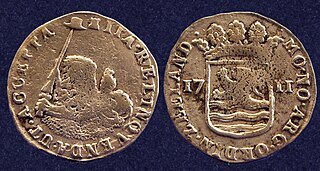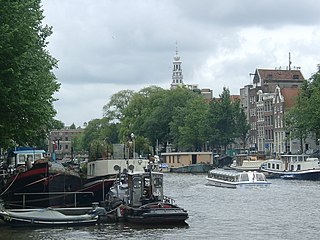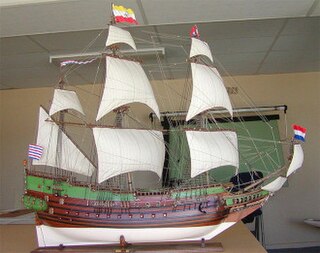
Batavia ( ) was a ship of the Dutch East India Company (VOC). She was built in Amsterdam in 1628 as the flagship of one of the three annual fleets of company ships and sailed that year on her maiden voyage for Batavia, capital of the Dutch East Indies. On 4 June 1629, Batavia was wrecked on the Houtman Abrolhos, a chain of small islands off the western coast of Australia.

The United East India Company, commonly known as the Dutch East India Company, was a chartered trading company and the first joint-stock company in the world. Established on 20 March 1602 by the States General of the Netherlands amalgamating existing companies, it was granted a 21-year monopoly to carry out trade activities in Asia. Shares in the company could be purchased by any citizen of the United Provinces and then subsequently bought and sold in open-air secondary markets. The company possessed quasi-governmental powers, including the ability to wage war, imprison and execute convicts, negotiate treaties, strike its own coins, and establish colonies. Also, because it traded across multiple colonies and countries from both the East and the West, the VOC is sometimes considered to have been the world's first multinational corporation.

Sir Constantijn Huygens, Lord of Zuilichem, was a Dutch Golden Age poet and composer. He was also secretary to two Princes of Orange: Frederick Henry and William II, and the father of the scientist Christiaan Huygens.

Zuytdorp, also Zuiddorp was an 18th-century trading ship of the Dutch East India Company.
The Eendracht was an early 17th century Dutch wooden-hulled 700 tonne East Indiaman, launched in 1615 in the service of the Dutch East India Company (VOC). Its Dutch name means "concord", "unity" or "union", and was a common name given to Dutch ships of the period, from the motto of the Republic: Concordia res parvae crescunt . The ship was captained by Dirk Hartog when he made the second recorded landfall by a European on Australian soil, in 1616.
Ridderschap van Holland was a large retourschip, the largest class of merchantmen built by the Dutch East India Company to trade with the East Indies. In 1694 the ship sailed for Batavia on her fifth voyage, but was never heard from again. She is now thought to have been shipwrecked off the west coast of Australia.
The Vergulde Draeck, also spelled Vergulde Draak and Vergulde Draek, was a 41.8-metre (137 ft), 260-tonne (290-ton) ship constructed in 1653 by the Dutch East India Company.
Abraham Momber, also known as Abraham Momber van de Velde, was the last commander (opperhoofd) of the Dutch East India Company settlement on Mauritius. He followed Roelof Deodati as the de facto Dutch governor on November 25, 1703. On November 15, 1707, the VOC's premises, goods, and administration were almost entirely destroyed by a fire.

The Zeewijk was an 18th-century East Indiaman of the Dutch East India Company that was shipwrecked at the Houtman Abrolhos, off the coast of Western Australia, on 9 June 1727. The survivors built a second ship, the Sloepie, enabling 82 out of the initial crew of 208 to reach their initial destination of Batavia on 30 April 1728. Since the 19th century many objects were found near the wreck site, which are now in the Western Australian Museum. The shipwreck itself was found in 1968 by divers.
't Wapen van Hoorn was a 17th-century Dutch East India Company fluyt with a tonnage between 400 and 600, built in the Dutch Republic in 1619. During its second voyage it grounded on the west coast of Australia, making it about the tenth ship to make landfall on Australian soil, and following Tryall just a few weeks earlier only the second ship to be shipwrecked in Australian waters, albeit temporarily.
Vianen was a 17th-century Dutch East Indies Company sailing ship, used to transport cargo between Europe and the Indies. She was shipwrecked but refloated on her first voyage, and shipwrecked and sunk on her second. Built at Amsterdam in 1626, she had a gross tonnage of 400.
Fortuyn was a ship owned by the Chamber of Amsterdam of the Dutch East India Company that was lost on its maiden voyage in 1723. It set sail for Batavia from Texel in the Netherlands on 27 September 1723. The ship reached the Cape of Good Hope on 2 January 1724, and continued on its voyage on 18 January. Fortuyn was never seen again and its fate is a matter of speculation.

Leeuwin, was a Dutch galleon that discovered and mapped some of the southwest corner of Australia in March 1622. It was captained by Jan Fransz and was the seventh European ship to sight the continent.
Thirteen ships of the Dutch East India Company and its pre-companies have been named Amsterdam.

Constantijn Huygens Jr., Lord of Zuilichem, was a Dutch statesman and poet, mostly known for his work on scientific instruments. But, he was also a chronicler of his times, revealing the importance of gossip. Additionally, he was an amateur draughtsman of landscapes.

Constanti(j)n Ranst de Jonge was a Dutch businessman employed by the Dutch East India Company (VOC) who was chief of the trading posts in Tonkin and Dutch Bengal and three times opperhoofd of Dejima in Japan.

Johan Bax van Herenthals, also written as Joan Bax, and van Herentals, was born in 's-Hertogenbosch and was the governor of the Dutch Cape Colony from 1676 succeeding the acting interim governor IJsbrand Godske. Agriculture developed during his term and he is recognized as contributing to the development of Botany and Ethnobiology. He declared two wars with the Khoikhoi. He died in Cape Town.
The Leeuwin was a 400-ton jacht of the Dutch East India Company that travelled to the East Indies twice starting 3 April 1653. It wrecked near Macassar on 24 December 1664.
Johan Cornelis d'Ableing , was secunde and acting governor at the Cape.

The Oosterland was a large 17th-century East Indiaman of the Dutch East India Company. The VOC was established in 1602. The ship was wrecked along with another ship by the ship the Kallendijk on 24 May 1695. The shipwreck was discovered by amateur divers in 1988 on the South African coast a few hundred metres from the entrance to Milnerton Lagoon at the mouth of the Salt River. Excavation of the wreck started in the early 1990s in combination with the University of Cape Town and was led by Bruno Werz.









